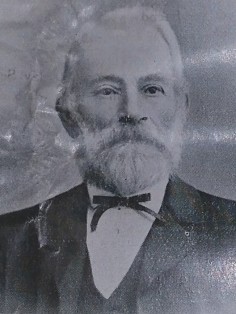Collingwood Notables Database
Charles Baker
1821-1897
Anglican layman, printer
Baker was a fervent adherent of the Church of England and involved with the parishes of St Mark’s in Fitzroy, St Philip’s in Abbotsford, and St Andrew’s in Clifton Hill. He was a strong opponent of pew rents.
Born in Birmingham, one of a family of eleven, he left school at the age of 13 to work at ivory and wood carving. Strongly committed to Anglicanism from a young age, he taught Sunday school in the 1840s. He arrived in Victoria early in 1850, paying a sailor to carry him on his back to shore, as there was no pier at Liardet’s Beach (now Port Melbourne). He obtained work as a printing compositor at the Melbourne Herald, had a brief foray to the goldfields in 1851 then worked for the temperance publication The Advocate. Eventually he was appointed to the Victorian Government Printing Office where he became an overseer until his retirement in 1883. He bought property in Collingwood not long after his arrival, living at first in Stanley Street and moving to Hoddle Street by 1863. In the 1860s he bought a parcel of land in newly subdivided South Terrace.
Baker became a committee member at St Mark’s in Fitzroy. This was the only local place of worship until services conducted by laymen were introduced at the Abbotsford Denominational School from the late 1850s. St Philip’s, Abbotsford became a separate parish in 1863 and Baker was a trustee and honorary secretary. He was a generous donor to the churches.
Baker denounced ‘the class distinction in our churches, the principal cause of which is the allotment of Seats.’ He called on the Church to ‘abolish private ownership and to restore to the people their … privileges as Christians and their inalienable rights as citizens.’ (Church of England Record Nov 11 1861). At a meeting of St Philip’s vestry in 1863 Baker succeed in getting a motion passed that all seats would be free. His victory in what would have been the first Anglican church established on the ‘voluntary principle’ was short-lived, the decision being altered later that year. Not discouraged, Baker again took up his advocacy in 1870 when the congregation of what became St Andrew’s first met, and was to have greater success there.
The meeting had been called because Baker was concerned that residents to the north of Collingwood were isolated from the parish of St Philip’s, and he apparently foresaw that Clifton Hill would eventually become much more populous than its undeveloped state in 1870 would suggest. The meeting discussed the building of a worship centre, which would operate under the aegis of St Philip’s. Willing Anglican workers set to, constructing a little wooden church in Gold Street, which became St Andrew’s Clifton Hill. The Rev Barnabas Walker, the first incumbent of St Philip’s, conducted the first service on January 1871. Baker then conducted services in his capacity as Lay Reader.
By 1874 Baker had built two adjoining houses in South Terrace, living at what is now number 21. He maintained a large garden on the east side of his residence (where numbers 22 to 25 now stand). His son Charles married a niece of the Rev Barnabas Walker, was appointed Sunday School superintendent at St Andrew’s and became the first Secretary. His daughter Elizabeth married Joseph Gabriel, a Victoria Street chemist and St Philip’s parishioner, at St Andrew’s. By 1880 Baker argued that the time had come for the promotion of St Andrew’s to the status of a parish and this was achieved on 5 November.
Baker was fond of writing poems, acrostic puzzles and short pieces on journeys and landscapes. These were assembled in a small book, which he published in 1889. Some of his work also appeared in The Observer. He was a doting grandfather and took great pleasure in seeing the little ones playing in his garden, even when they were getting their little faces and hands smeared with mulberry juice. Sadly he lost his wife and both sons but had strong support from his daughter and son-in-law.
Baker had connections with a wide cross-section of Collingwood inhabitants, with his many acquaintances at St Philip’s and St Andrew’s, his Masonic connections, and the voluntary militia group the East Collingwood Rifles in which he was a corporal. There were also family connections. His sister Mary married James Bowring, a Collingwood councillor and baker, and sister Fanny was the wife of James Levens, well-known draper of Wellington Street. Nathaniel Berry, whose descendants would remain in Collingwood well into the twentieth century, had travelled on the same ship and remained a lifelong friend.
Life Summary
| Birth Date | Birth Place |
|---|---|
| 13 September 1821 | Birmingham, England (23 Worcester Street). |
| Spouse Name | Date of Marriage | Children |
|---|---|---|
| Mary (c. 1813- 14 December 1886) | 1840s | Elizabeth (c. 1846-1938), Charles (c. 1848-1896), Matthias (1857-1894) |
| Home Street | Home City | Status of Building |
|---|---|---|
| 6 Stanley Street | Collingwood | Demolished |
| Hoddle Street | Abbotsford | Not identified |
| 21 South Terrace | Clifton Hill | Extant |
| Church | Lodge |
|---|---|
| St Philip's Anglican, Hoddle Street Abbotsford | Freemason: Combermere Lodge and Carnarvon Lodge |
| St Andrew's Anglican, Gold Street Clifton Hill |
| Death Date | Death Place | Cemetery |
|---|---|---|
| 19 April 1897 | Clifton Hill | MGC |
The Argus; The Mercury; The Observer; Baker, Some fragments of the leisure hour; Cawcutt, All seats free; Baker, Historical notes on the church and parish of St Mark the Evangelist; St Philip’s joint report of the trustees and committee; Clarke-Hudson, History of St. Andrew's Church, Clifton Hill, 1871-1921.

